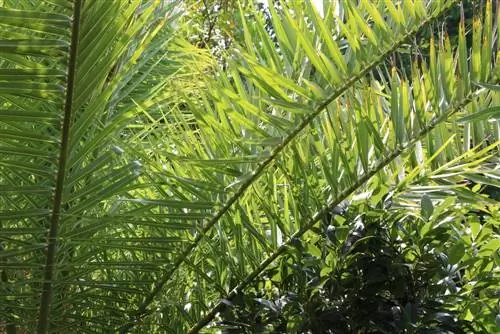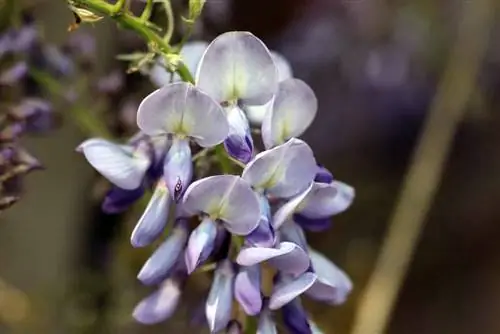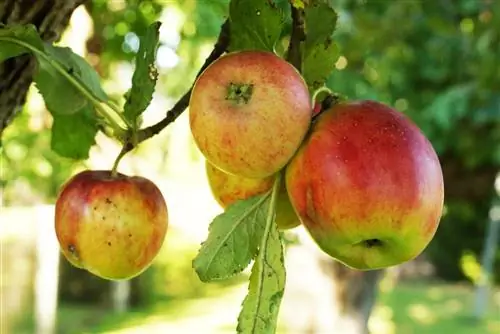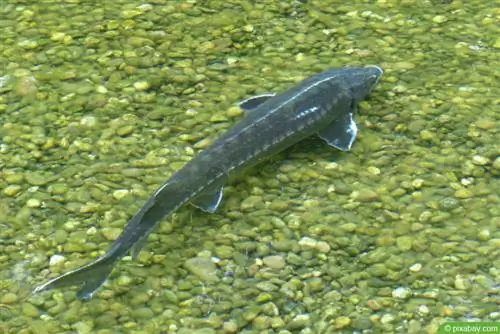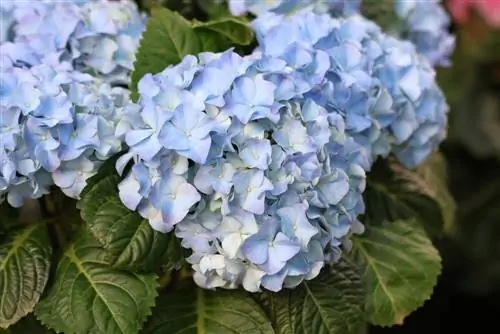- Author admin [email protected].
- Public 2023-12-17 03:39.
- Last modified 2025-01-24 12:45.
The Canary Island date palm gives the living room, winter garden or even the terrace a tropical flair and is easy to care for. This makes it ideal for beginners and anyone who doesn’t have a green thumb. Despite its undemanding nature, a few points must be taken into account when cultivating the Phoenix canariensis.
Location
The Canary Islands date palm comes from tropical climes and therefore requires a warm and sunny location. It tolerates room temperatures all year round, but can also be left outdoors from spring to late summer.
The most important thing is that it receives enough light. A dark corner of the room is therefore extremely unsuitable. Areas in the immediate vicinity of windows or the winter garden are better. It should also be noted that the Phoenix canariensis can reach considerable sizes - and in a relatively short time. There should also be enough free space at the location.
Substrate
The Canary Islands date palm requires a nutrient-rich, permeable and slightly acidic substrate. The soil should also have moderate, moisture-retaining properties. A mixture of: is therefore well suited
- well-rotted compost
- potting soil
- Sand
- Palm Soil
The individual components can be mixed together in equal parts.
Tip:
To avoid waterlogging, a drainage layer should be placed in the planter. Potsherds, expanded clay or coarse gravel are ideal for this. Here too, mixtures of the individual components are possible.
Plants and planters
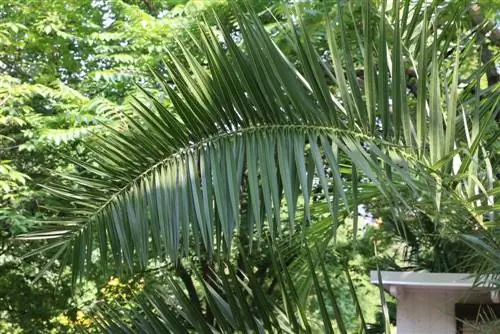
Since the Canary Island date palm is not frost hardy, it should be cultivated in a bucket. The following are important when choosing the right planter:
- high stability
- the largest possible scope
- a plant trolley as a mobile base
Due to the size and weight of the plant, you should definitely not go without a sturdy plant roller. This base is indispensable simply to be able to rotate the Phoenix canariensis regularly to promote even growth. A coaster or planter should also be used to avoid water damage to the surface.
Pouring
When watering the Phoenix canariensis, only two factors are crucial: frequent and low in lime. The Canary Islands date palm thrives best in a substrate that is always moist. However, it should neither be exposed to waterlogging nor watered with hard tap water.
Ideal for watering are:
- stale tap water
- untreated pond or aquarium water
- filtered water
- Rainwater
If aquarium or pond water is used, the Canary Island date palm is also supplied with nutrients. Therefore, fertilization can be saved.
Fertilize
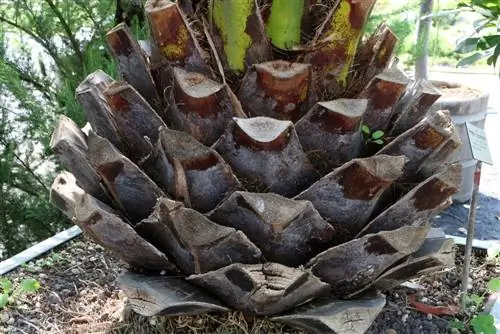
From spring onwards, the Canary Islands date palm is fertilized every two weeks. Palm fertilizer has proven to be ideal as a fertilizer. However, it should be noted that the Phoenix canariensis is sensitive to s alt. Therefore, only a small dose of fertilizer should be administered. It is also important that the palm tree is watered abundantly after fertilizing. This distributes the nutrients evenly and prevents high concentrations of nutrients from causing chemical burns on the roots. In winter, the interval between nutrient doses is extended. It is then sufficient to fertilize every six weeks.
Cleaning
The sprawling leaves or fronds of the Canary Island date palm collect dust over time, becoming dull and appearing gray. Apart from the visual impairment, these coverings also prevent the unhindered release of excess moisture via the leaves. It is therefore advisable to clean the leaves as soon as necessary. These can be wiped with a damp cloth or showered. To ensure that the water does not cause new deposits to form again due to the lime content, the palm fronds should then be wiped with a dry, lint-free cloth.
Repotting
Repotting the Canary Island date palm should always be done when the substrate is used up or the bucket has become too small for the plant. The latter can be noticeable in that the stability deteriorates. This happens when the Phoenix canariensis becomes too top-heavy, i.e. the center of gravity shifts too far up. Two further indications are visible roots at the bottom of the pot and slowing growth. Such signs should be taken seriously and lead to repotting as quickly as possible.
The following instructions can help:
- For larger Canary Island date palms, at least two people should do the repotting. Due to the large size and weight, the measure is difficult to carry out alone.
- The old substrate must be removed as completely as possible. In order to gently remove the residue and not damage the roots, we recommend soaking the root ball and then rinsing it with a little water pressure.
- A drainage layer is placed in the bucket so that the roots are not directly in the water.
- There is enough soil on the drainage layer so that the date palm is at the right height from the top edge of the pot after it has been set. Finally, the bucket is filled with soil that is as dry as possible, as it is easier to distribute. The substrate is lightly pressed and watered immediately, as this will cause the soil to sink further if necessary and can be refilled accordingly.
As a rule, repotting should be carried out approximately every three years.
Blend
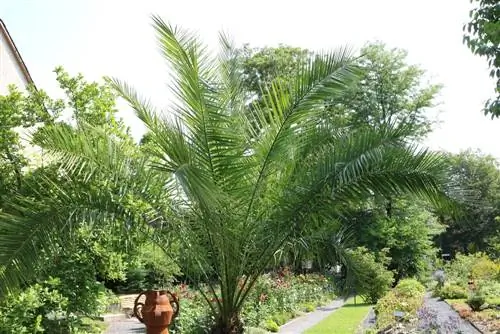
The Canary Island date palm itself does not need any trimmings. The only exception are the fronds. Over time, the lower palm fronds die and dry up. As soon as they have completely dried out, they can be cut off close to the plant. A sharp knife or secateurs is recommended for this. In some cases, greater force must be used to remove the dried leaves. Robust cutting tools should therefore be used.
Propagation
The Canary Islands date palms are propagated via seeds that develop after flowering in spring. It is ideal to sow the seeds as quickly as possible. The procedure is as follows:
- The seeds are removed from the pulp and cleaned.
- The seeds are then soaked in lukewarm water for a few days and should be kept warm during this time.
- Placed in potting soil, the seeds of the Phoenix canariensis are kept moist and warm. Temperatures should be between 20 and 25 °C at the location.
- Germination begins after two to three months. If the growing soil is rooted, the young plants can be repotted into the substrate described above.
At first the young plants are more reminiscent of grass. The characteristic frond shape only appears when the plants are two to three years old.
Tip:
In order for the flowers to produce fruit, they must be fertilized. Therefore, during the flowering period between February and May, they should be left outdoors on warm days or fertilized with a brush.
Wintering
The Phoenix canariensis is not frost hardy and must therefore be overwintered accordingly. There are two options for this. On the one hand, the Canary Islands date palm can still be cultivated at room temperatures, i.e. left in the living room. Watering takes place as usual. However, the intervals between fertilization can be extended up to six weeks.
A little more natural and, based on experience, better for the resilience of the Canary Island date palm is cooler overwintering. The plant should be kept in a bright room at temperatures of 10 to 15 °C. For example, the hallway, a greenhouse with optional heating or a winter garden are suitable. You should continue to water here too. As mentioned, light fertilization with very small amounts can be carried out every six weeks in combination with watering.
Tip:
If you don't have space to overwinter the Canary Island date palm in your own home, you can also have it overwintered professionally in nurseries that offer appropriate supplies.
Growth per year
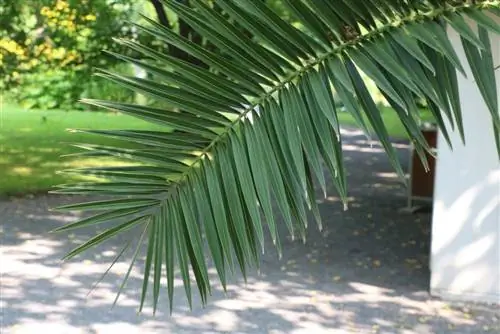
The Phoenix canariensis grows by around 50 centimeters annually if care and location are optimal. That may not sound like much at first, but it represents a potential growth of 1.5 meters in three years. Over time, a trunk also develops, although when cultivated indoors it usually remains very short. Growth mainly refers to the length of the palm fronds and therefore the circumference of the plant.
Typical diseases, pests and care errors
Diseases and pests usually only affect the Canary Islands date palm if it is weakened by a mistake in care and is therefore more vulnerable. Typical in these cases are:
Callus disease
The disease manifests itself as black dots on the leaves. A risk factor is a location with too little light and temperatures that are too high.
Leaf spot disease
This widespread fungal infection appears in the form of almost circular, light to dark brown spots on the leaves or fronds. Cold and very hard irrigation water can increase the risk of infection.
Spider mites
The pests make themselves noticeable through fine weaving between the leaves and appear primarily in winter, when dry and warm heating air causes problems for the plant. Cool wintering and spraying or showering the Canary Island date palm can help.
Scale insects
The parasites can be recognized by brownish, raised structures that are primarily found on the bases and undersides of the leaves. These 0.6 to 0.8 millimeter large structures are the scale insects themselves. They also occur primarily in dry, warm indoor air.
Mealybugs
The pests are light to white and have woolly, greasy hair. They typically spread in winter when the plant is too warm and dry. If the Phoenix canariensis is attacked by pests or diseases, the culture conditions should be checked and appropriate control measures should be used. A coordinated culture as well as spraying, showering or wiping the palm fronds with a damp cloth have a preventive effect.

